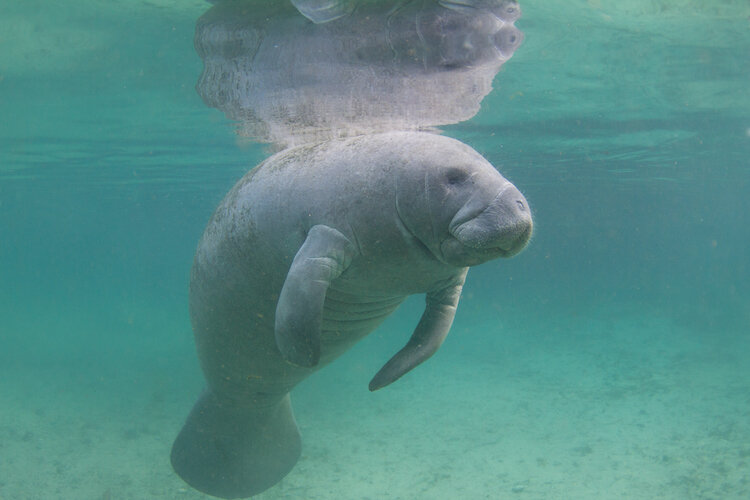Dugongs are animals that live in the sea.
They live in shallow, warm sea.
They eat sea grass.
Dugongs are covered with skin.
They live together in groups called herds.
Dugongs are large marine mammals.
©Getty Images
They are found in tropical and near-tropical seas around the world. They spend their entire lives in the water.
Although they resemble dolphins in some ways, they are actually more closely related to elephants.
Habitat and distribution (where they are found)
Dugongs are found in the largest numbers in Australian waters, where they live in the shallower part of the seas of northern Australia. They also swim in deeper water, but in areas that are protected from large waves and storms. They are also found in parts of the Indian and Pacific oceans.
Appearance and Behaviours
Dugongs have short tusks, but in the females they are much smaller, less developed. The shape of the dugong's tail is similar to that of a dolphin, having two flukes.
Dugongs are a greyish brown colour. ©iStock
Dugongs are about 3 m long, and weigh up to 400 kg. The heaviness of the animal helps it stay on the sea floor without breathing, which it can do for around six minutes. They are a greyish brown colour, and are hairless except for bristles near the mouth.
Being mammals, they must breathe air, and come to the surface to breathe through nostrils on the top of their snouts. Their nostrils close when they are underwater.
Dugongs are slow-moving animals with little defence against predators. They are often seen alone or in pairs, but can be gathered in groups called herds.
Dugong grazing the sea grass ©Getty Images
Diet
Dugongs eat the sea grass that grows in warm, quite shallow seas. Sea grasses are marine plants that look like grass, and grow on the sandy sea floor in shallow, warm seas. As they graze, dugongs 'walk' their flippers along the sand, rising to the surface every so often to breathe. The dugong's head has large cheeks called jowls that help push the sand away from its mouth as it eats so that it never swallows sand.
Because of their grass diet and how they feed, dugongs are often called 'sea cows'.
Life cycle
About one year after mating with a male, a female dugong gives birth to one calf. A female has a calf every four or five years, and gives birth underwater. To keep the newborn calf safe from sharks, the female moves to shallow water that is protected by sand bars when she is ready to give birth.
The young stays with its mother for one to two years, sometimes hitching a ride by hanging on to its mother's back. The female dugong has one teat under each flipper, and the young suckle milk. Calves shelter for safety behind their mother when threatened.
Dugongs can live for about 70 years.
Conservation Status and Threats
©Getty Images
Dugongs are classified as Vulnerable. They were once common throughout the Indian Ocean but now there are only a few thousand left in the Persian Gulf and the Red Sea, and just a few hundred in Asia.
Dugongs were once hunted for their meat, oil, skin and tusks but are now protected. Their natural predators are sharks, crocodiles and killer whales.
The main threats to dugongs, however, are humans. Like dolphins, dugongs are often caught in fishing nets and drown.
The sea grass beds where they feed are being depleted, dying off because of pollution along the coastline.
Because about three quarters of the world's population of dugongs are now in Australian waters, they are important and are protected in sanctuaries and marine national parks in Australia.
A manatee is related to the dugong. The tail is one of the differences between them. ©Getty Images
Did you know?
There is a similar marine mammal called a manatee. However, although related, they are a different species from the dugong. In particular, their tail is different: manatees have a tail like a paddle and dugongs have a tail similar to that of a dolphin. Look at the pictures to compare.
It is said that sailors in olden times saw dugongs and thought they were mermaids!
A dugong’s tail is different from a manatee’s. It is more like a mermaid’s tail! ©Getty
Read more about dugongs and watch a video:
https://www.activewild.com/dugong-facts/







